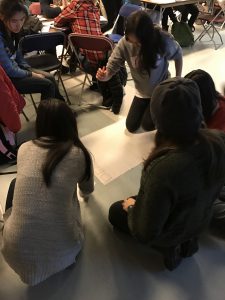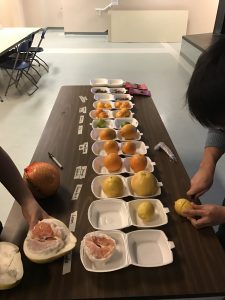When faced with the reality of teaching online we have two choices: (1) try to bend our current pre-pandemic courses and ways of teaching into an online format, or (2) start from scratch and call a do-over.
I chose the latter.
I am not a stranger to tackling learning in new unexpected spaces. My truth is, I enjoy the creative aspect of the brass tacks of course design. What constraints do we have? What are our goals? Where are we going? A few years ago, we lost our large lecture theatre due to renovations on BioSciences. Space was tight, so I finagled teaching a section of our large biology course in one of our residence halls – specifically, downstairs in the ballroom. (This was a feat of creativity supported and crafted by UBC housing, Food Services – who brought us hot chocolate in the evenings, the Centre for Student Involvement and Careers, and the Biology Program – all of whom decided this was a worthwhile effort.) The course ran twice per week at 7PM, and we affectionately called it “the pajama section”.
This summer, when I began thinking about how to transform a course for online teaching, I recognized the process. This was not so different from taking a large lecture course from a big theatre into a ballroom. Here are my top principles to consider:
1. What does this new environment provide that the old one did not? Teaching in a residence ballroom meant a lot of losses. There were no seats, no blackboards or whiteboards, no projection system. But it did have open space that we do not get in lecture theatres. It had open, accessible walls. It had room to dance! And so we did (with pool noodles as chromosomes).
We used the vast space to create things.

We used the walls as galleries.

We hauled in chairs each week, and students began arriving early to help unfold them. Together we crafted a magical learning space that was different but special. Students learning from home this year have lost a lot of the experience they would have in our face-to-face classrooms. What have they gained? What do they have access to now that they do not have access to in a classroom? The answers here may be particular to a specific course, but the universal principle is the same. (As an example for my course this term (a third year laboratory course), one of the things they gained is temporal – they can do their lab activities at home anytime during the week. They are not constrained to a particular lab section.)
2. Step 1 provides a frame shift towards recognizing that learning from home can be better (in some ways) instead of just adequate. How can this new environment be leveraged in a positive way? This is not unlike the process of flipping a classroom. Start small – maybe with one or two lessons. Creating one amazing thing that students can do at home that they can NOT easily do in a face-to-face classroom can fundamentally shift the attitude towards an online course. (As an example, my students learned about the importance of calibrating an instrument by calibrating their ovens. They document behaviour of birds and/or squirrels out their windows).
3. As I work through the iterative process of “what do they have access to?” and “how can that be leveraged?”, sometimes there are nice places where old curriculum overlaps, and sometimes there is not. Don’t be afraid to let go of the old stuff and do something new. Let’s face it. We are functioning in an emergency teaching situation. We won’t hit all the targets. If something doesn’t transform effectively, get rid of it. Or replace it with something new. One “new” we had in our ballroom was learning about different types of hybrid citrus fruit (from an amazingly small number of wild species), which had nothing to do with anything in our normal curriculum – but it was fun and the students learned something different. Give yourself the opportunity to play and have fun. You will likely stumble onto some teaching tricks or activities that will make your online classrooms even better the next time around.
